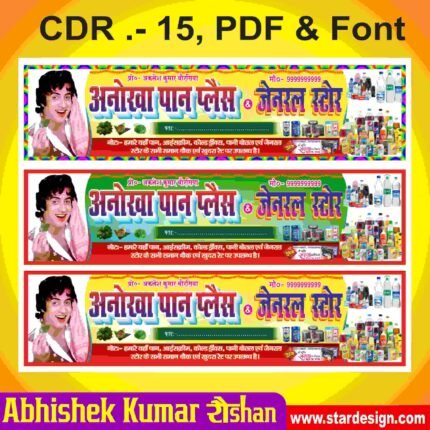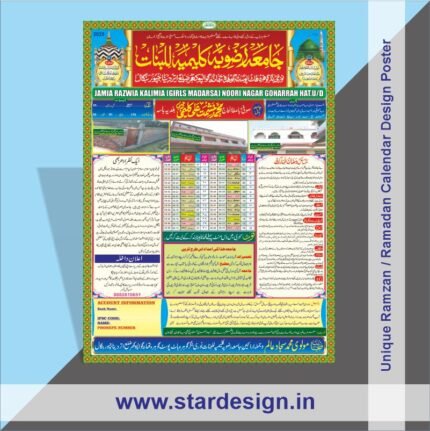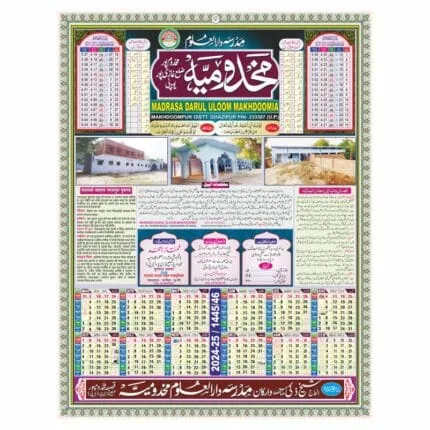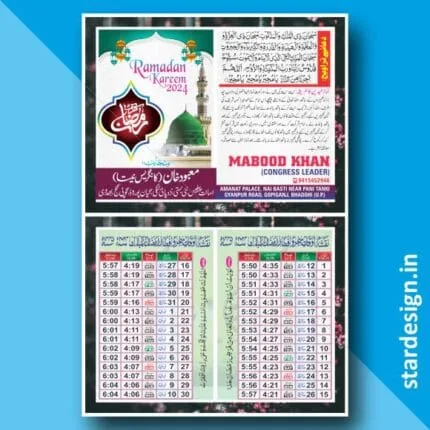Introduction to Ramzan Card Design
Ramzan, also known as Ramadan, is a significant month in the Islamic calendar, characterized by fasting, prayer, reflection, and community. During this holy month, Muslims engage in spiritual growth and seek to strengthen their connection with Allah, while also fostering a sense of unity within their communities. One of the cherished traditions associated with Ramzan is the exchange of greeting cards, which serve as tokens of goodwill and heartfelt sentiments among family and friends. These cards often convey blessings, inspirational messages, and well-wishes, thereby reinforcing relationships during this auspicious period.
The practice of sending Ramzan greeting cards holds considerable cultural importance, as it reflects an appreciation for artistry and creativity. A well-designed card not only communicates festive greetings but also embodies the spirit of the occasion through its visuals and artistic nuances. The significance of creativity in Ramzan card design cannot be overstated, as it transforms ordinary messages into memorable expressions of affection and kindness.
With advancements in technology, the process of designing Ramzan cards has become remarkably accessible, thanks to graphic design software such as CDR (CorelDRAW). This powerful tool enables users to create stunning and visually appealing card designs with ease. CorelDRAW offers a wide array of features, including advanced vector illustration tools, comprehensive design layouts, and the ability to manipulate colors and shapes seamlessly. Whether you are a seasoned designer or a novice exploring your artistic side, CDR provides endless possibilities for producing unique Ramzan cards that resonate with the intended audience. Embracing creativity in card design not only personalizes your greetings but also ensures that they leave a lasting impression during this holy month.
Key Elements of Ramzan Card Designs
When creating Ramzan card designs in CorelDRAW (CDR), it is essential to incorporate several key elements that resonate with the spirit and significance of this holy month. Firstly, the use of Islamic motifs is paramount. Intricate patterns, geometric designs, and Arabesque artwork can enhance the aesthetic appeal and give a traditional feel to the card. These motifs serve not only as decoration but also as a reflection of the rich cultural heritage of Islamic art.
Another crucial element is the inclusion of calligraphy. Arabic calligraphy, especially when it features phrases from the Quran or well-known greetings such as ‘Ramadan Kareem,’ adds a personal touch and a profound message to the design. Choosing the right font is vital; elegant and flowing scripts can capture the essence of the month while ensuring readability. In CorelDRAW, various font options can be utilized to achieve distinct styles that enhance the overall design.
Color schemes play an important role in setting the mood of Ramzan cards. Traditional colors such as deep blues, golds, greens, and whites are often associated with this celebratory period. These colors not only attract attention but also evoke feelings of peace, spirituality, and festivity. When selecting colors, consider how they complement each other and contribute to the overall cohesiveness of the design.
Imagery such as crescent moons and stars are symbolic of Ramadan and should be an integral part of the design. These elements can be depicted in a variety of styles, ranging from minimalist to ornate. The crescent moon, in particular, symbolizes the beginning of the month and can serve as a focal point in the design. By combining these elements thoughtfully, designers can create captivating Ramzan cards that convey the essence of this sacred month effectively.
Step-by-Step Guide to Designing Ramzan Cards in CDR
Creating a Ramzan card using CorelDRAW (CDR) is a rewarding endeavor that allows for personal expression and creativity while celebrating an important occasion. This step-by-step guide will assist you in designing your own unique Ramzan cards.
Begin by launching CorelDRAW and setting up a new document. Navigate to ‘File’ > ‘New’ and select your preferred dimensions. A typical size for greeting cards might be 5×7 inches, but you can customize this based on your design needs. Ensure that you set the resolution at 300 DPI for high-quality printing.
Next, consider utilizing templates. CorelDRAW offers a range of pre-designed templates that can serve as a strong foundation for your project. You can access these by choosing ‘File’ > ‘Templates’ > ‘Open Templates’. Select a template that resonates with the spirit of Ramzan and allows you to modify elements to suit your vision.
Once you have your base, begin incorporating key design elements reflective of Ramzan, such as crescent moons, stars, and ornate patterns. Use the ‘Shapes’ tool to create these icons or import vector graphics that you can manipulate. It’s advisable to maintain a cohesive color palette that aligns with the symbolism of Ramzan, typically deep blues, golds, and whites.
Layering is crucial in achieving depth in your design. Access the ‘Object’ menu to manage layers efficiently. This will allow you to organize your elements clearly, so adjustments don’t disrupt the entire layout. Applying effects such as shadows, gradients, and transparencies can significantly enhance your design’s visual appeal.
Finally, when your design is complete, export your card for printing or digital sharing. Go to ‘File’ > ‘Export’ and choose your desired file format, such as PDF for printing or JPEG for social media. Ensure that all settings optimize quality and compatibility. With these steps, your Ramzan card will be ready to spread joy and blessings during the holy month.
Inspiration and Trends for Ramzan Card Designs
The design of Ramzan cards has evolved significantly over the years, blending cultural traditions with modern aesthetics. In exploring the current trends for designing these cards, one can find numerous styles that cater to different tastes and preferences. Minimalist designs have gained popularity for their clean lines and simplicity. These cards typically feature limited color palettes, elegant typography, and subtle Islamic motifs, allowing the message of goodwill to take center stage without unnecessary embellishments. Such designs resonate well with individuals favoring an understated yet sophisticated approach.
In contrast, traditional Ramzan card designs often celebrate cultural heritage by incorporating intricate patterns and vibrant colors. This can include geometrical shapes inspired by Islamic art, combined with traditional Arabic calligraphy conveying thoughtful greetings. Using rich golds, deep blues, and lush greens, these cards evoke a sense of nostalgia and reverence for the holiday. For example, one might encounter cards adorned with imagery of mosques, crescent moons, or lanterns, all of which symbolize the spirit of Ramzan.
On the contemporary front, there are innovative designs that merge classic themes with modern graphic design techniques. These may include playful illustrations or digital artwork that engages younger audiences while still honoring the core values of the season. A popular trend involves using interactive features or augmented reality elements to enhance the card’s appeal—a practice that encourages sharing and connection through social media platforms.
By examining these various trends and styles, individuals can take inspiration to create their own unique Ramzan cards. Whether one prefers the simplicity of minimalism, the richness of tradition, or the flair of contemporary design, each style offers a different way to express heartfelt messages during this auspicious month. Embracing the spirit of creativity, designers can craft cards that resonate on a personal level with recipients.
Final Touches and Sending Your Ramzan Cards
When it comes to enhancing your Ramzan card designs, the final touches can contribute significantly to their overall appeal. One effective way to personalize your cards is by including a heartfelt message that reflects the spirit of Ramzan. Consider writing a short note of gratitude or well wishes for the recipient, as this adds a unique touch that resonates with the warmth of the occasion. Depending on the design, you might choose elegant fonts, decorative text boxes, or hand-written elements that reflect your personal style.
In addition to messages, using decorative envelopes can elevate the presentation of your cards. A beautifully designed envelope can create anticipation for the recipient, making them feel valued. Consider using colors and motifs that complement your card design. You might add embellishments such as stickers, ribbons, or even calligraphy that aligns with the theme of Ramzan, further showcasing your creativity and effort.
As for sending your Ramzan cards, there are several options to consider. Traditional mailing remains a popular choice, as it conveys a sense of sincerity and thoughtfulness. Make sure to adhere to postal guidelines to ensure your cards arrive in good condition. If you opt for digital platforms, numerous greeting card websites allow you to design and send e-cards, which can be a practical alternative, especially for those living long distances away. Social media platforms also provide a quick way to share your custom designs with friends and family, ensuring your greetings reach people regardless of geographical barriers.
It is important to consider the timing of your card sending. Delivering your Ramzan cards early in the month can ensure they are received in time for the celebrations, allowing recipients to appreciate your thoughtful gesture. Balancing aesthetics, message, and timing will enrich the connection you foster through your greetings during this special month.












Reviews
There are no reviews yet.